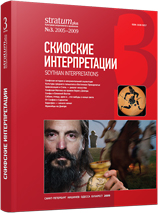О различных формах диалога искусства степи и цивилизаций: к постановке вопроса
On Different Forms of Dialogue Between the Art of Steppe and Civilizations: Statement of Question
Author(s): Elena V. PerevodchikovaSubject(s): History, Archaeology, Cultural history, Ancient World
Published by: Издательский дом Stratum, Университет «Высшая антропологическая школа»
Summary/Abstract: The article deals with the different forms of the dialogue of the art of steppe and civilizations of the Eastern and Western parts of the Eurasian steppe.D.S.Raevsky had perfectly described the cross-cultural contacts of the Scythian and Greek art it the North Pontic territory, where Greek artisans made gold items for Scythian chieftains. According to Raevsky, Greeks knew Scythian mythology and depicted on the traditionally nomadic items scenes of Scythian myths, working in their own artistic manner. Specimens of scythian art made by Greek craftsmen also have many features of Greek art.Looking for similar situation in the Eastern part of Eurasia, we see recently discovered Filippovka and Arzhan-2 with works of Scythian art in gold, part of them, of a high technical level, made by foreign craftsmen. Several items have inlays of glass, so nomadic craftsmen also could not make them.According to the recent studies by R.S.Minasian, iron daggers of Tagar culture were cast, not forged, the same about Arzhan iron weapon with gold. But casting iron in the Early Iron Age was known only in China, so these weapon could be made by Chinese craftsmen for the nomads because of purely nomadic forms and style of it.Eastern works of Scythian art made by non-nomadic artisans had no features of any foreign artistic tradition. We know that Chinese craftsmen made iron weapon, about other things we can say almost nothing but the fact that glass production is known only in the Near East and China.Comparing North Pontic and Eastern situations of cross-cultural dialogue, the similarity in the fact making gold items for nomads by foreign craftsmen, we see the main difference in the presence of absence of foreign features in the works of art. We may explain this difference not by technical level and knowledge of artisans, but by different cultural statements of the relations between masters and foreign craftsmen in the nomadic society.Though the results of our research are quite poor yet, we can put a question of the different models of the dialogue of the artistic traditions in the different parts of the Eurasian steppes.
Journal: Stratum plus. Археология и культурная антропология
- Issue Year: 2009
- Issue No: 3
- Page Range: 155-161
- Page Count: 7
- Language: Russian
- Content File-PDF

